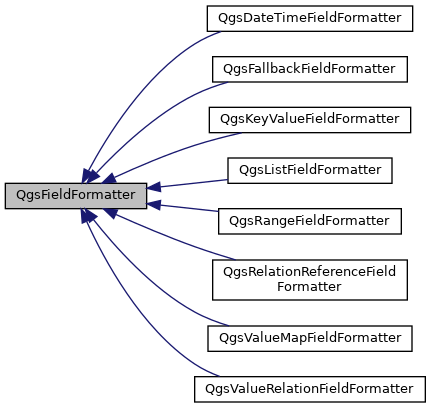A field formatter helps to handle and display values for a field. More...
#include <qgsfieldformatter.h>

Public Member Functions | |
| QgsFieldFormatter () | |
| virtual | ~QgsFieldFormatter ()=default |
| virtual Qt::AlignmentFlag | alignmentFlag (QgsVectorLayer *layer, int fieldIndex, const QVariantMap &config) const |
| Returns the alignment for a particular field. More... | |
| virtual QVariant | createCache (QgsVectorLayer *layer, int fieldIndex, const QVariantMap &config) const |
| Create a cache for a given field. More... | |
| virtual QString | id () const =0 |
| Returns a unique id for this field formatter. More... | |
| virtual QString | representValue (QgsVectorLayer *layer, int fieldIndex, const QVariantMap &config, const QVariant &cache, const QVariant &value) const |
| Create a pretty String representation of the value. More... | |
| virtual QVariant | sortValue (QgsVectorLayer *layer, int fieldIndex, const QVariantMap &config, const QVariant &cache, const QVariant &value) const |
| If the default sort order should be overwritten for this widget, you can transform the value in here. More... | |
Detailed Description
A field formatter helps to handle and display values for a field.
It allows for using a shared configuration with the editor widgets for representation of attribute values. Field kits normally have one single instance which is managed by the QgsFieldFormatterRegistry. Custom field formatters should be registered there and field formatters for use within code should normally be obtained from there.
This is an abstract base class and will always need to be subclassed.
- Since
- QGIS 3.0
Definition at line 40 of file qgsfieldformatter.h.
Constructor & Destructor Documentation
◆ QgsFieldFormatter()
| QgsFieldFormatter::QgsFieldFormatter | ( | ) |
Definition at line 23 of file qgsfieldformatter.cpp.
◆ ~QgsFieldFormatter()
|
virtualdefault |
Member Function Documentation
◆ alignmentFlag()
|
virtual |
Returns the alignment for a particular field.
By default this will consider the field type but can be overwritten if mapped values are represented.
- Since
- QGIS 3.0
Definition at line 49 of file qgsfieldformatter.cpp.
◆ createCache()
|
virtual |
Create a cache for a given field.
This will be used in situations where a field is being represented various times in a loop. And will be passed to other methods on QgsFieldKit and QgsEditorWidgetWrapper.
For example, the attribute table will create a cache once for each field and then use this cache for representation. The QgsValueRelationFieldFormatter and QgsValueRelationEditorWidget implement this functionality to create a lookuptable once (a QVariantMap / dict) and are make use of a cache if present.
- Since
- QGIS 3.0
Reimplemented in QgsValueRelationFieldFormatter, and QgsRelationReferenceFieldFormatter.
Definition at line 60 of file qgsfieldformatter.cpp.
◆ id()
|
pure virtual |
Returns a unique id for this field formatter.
This id will later be used to identify this field formatter in the registry with QgsFieldFormatterRegistry::fieldFormatter().
This id matches the id of a QgsEditorWidgetFactory.
Implemented in QgsValueRelationFieldFormatter, QgsValueMapFieldFormatter, QgsDateTimeFieldFormatter, QgsKeyValueFieldFormatter, QgsRelationReferenceFieldFormatter, QgsListFieldFormatter, QgsFallbackFieldFormatter, and QgsRangeFieldFormatter.
◆ representValue()
|
virtual |
Create a pretty String representation of the value.
- Returns
- By default the string representation of the provided value as implied by the field definition is returned.
- Since
- QGIS 3.0
Reimplemented in QgsValueRelationFieldFormatter, QgsValueMapFieldFormatter, QgsDateTimeFieldFormatter, QgsKeyValueFieldFormatter, QgsRelationReferenceFieldFormatter, QgsListFieldFormatter, and QgsRangeFieldFormatter.
Definition at line 27 of file qgsfieldformatter.cpp.
◆ sortValue()
|
virtual |
If the default sort order should be overwritten for this widget, you can transform the value in here.
- Returns
- an unmodified value by default.
- Since
- QGIS 3.0
Reimplemented in QgsValueRelationFieldFormatter, QgsValueMapFieldFormatter, and QgsRelationReferenceFieldFormatter.
Definition at line 39 of file qgsfieldformatter.cpp.
The documentation for this class was generated from the following files:
- /tmp/buildd/qgis-3.6.0+99unstable/src/core/qgsfieldformatter.h
- /tmp/buildd/qgis-3.6.0+99unstable/src/core/qgsfieldformatter.cpp
 1.8.13
1.8.13